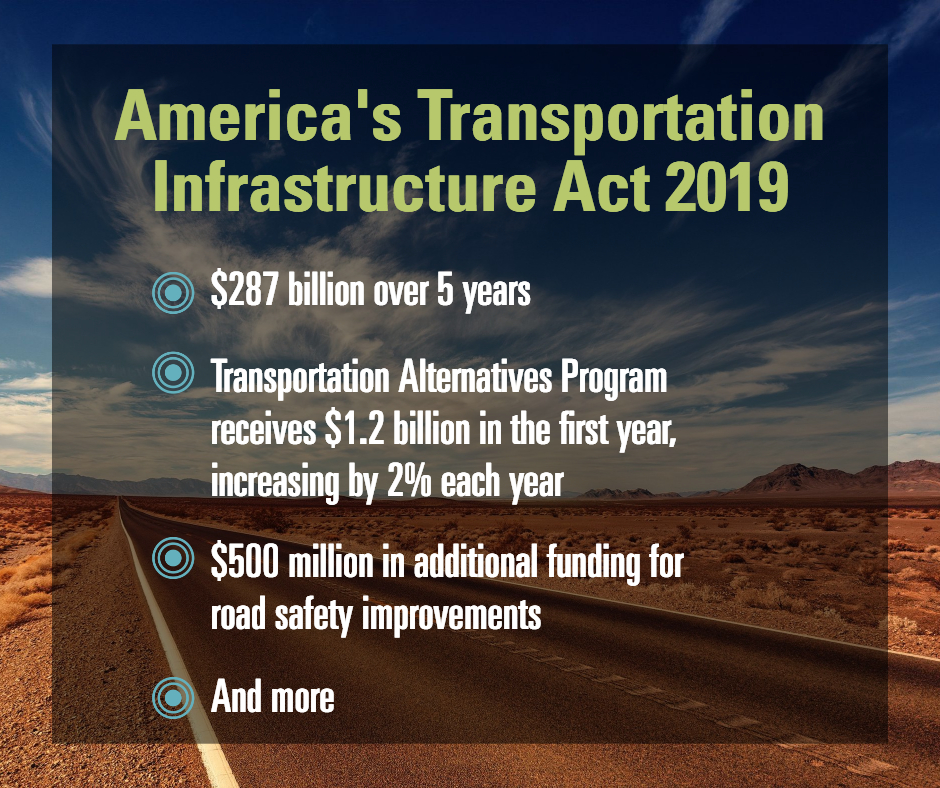$287 billion authorized over five years for surface transportation programs

On July 29, 2019, the Senate Environment and Public Works (EPW) Committee unveiled the new transportation reauthorization legislation, which will be under EPW Committee consideration on July 30, 2019. A bipartisan bill, it is being released by the four Committee leaders: Senators Barrasso (R-WY), Carper (D-DE), Capito (R-WV), and Cardin (D-MD). The current transportation law expires in September 2020, and this bill is being released well in advance of this in order to handle potential challenges in the legislative process. (How it will be paid for is one big question: read more on that topic in a story earlier in July from CityLab.)
The bill, known as ATIA 2019, authorizes $287 billion from the Highway Trust Fund over five years in investments. How will it differ from the existing programs? It maintains the core transportation programs that already exist, while adding several new initiatives. Safe Routes Partnership has a great blog post covering the many benefits this bill will have for the TAP program, bicycle and pedestrian safety, and more. Here are a few of the highlights:
Transportation Alternatives Program
The Transportation Alternatives Program (TAP) provides most of the funding for Safe Routes to School, biking, and walking projects. TAP will receive more funding and be easier to implement should the bill become law: funding increases from $850 million to $1.2 billion in the first year, then grow by 2% each year. It will also allocate more of those funds to local governments—57.5% rather than just 50%–and states may opt to allocate all their TAP funds to local governments. Non-profits of all kinds may also apply for TAP funding; previously, only those that administered safety programs could do so. Additionally, states may use up to 7% of TAP funding for support staff and technical assistance, which may help projects be completed faster.
Copyright: Carmanah Technologies
Bicycle and pedestrian safety
Improving road safety for vulnerable users—those walking or biking or those with disabilities—is front and center, with $500 million in additional funding each year for improving road safety. Any state with a metropolitan planning organization (MPO) that has above-average vulnerable user fatalities must spend half the new funds on improving safety through traffic calming, new sidewalks, bike lanes and trails, or additional lighting, among other improvements. Currently, $20 million per year, so this will be a significant boost. Additionally, states and MPOs that successfully reduce their fatalities or shrink the rate of growth become eligible to compete for another $100 million from the US Department of Transportation. To learn more about the districts that may need this funding most, read the Dangerous By Design addendum by clicking the “Most Dangerous Districts” tab.
Climate change and other provisions
Five programs in the legislation totaling $10 billion over five years are intended to help reduce greenhouse gas emissions. This includes $600 million per year for projects that help reduce carbon emissions through walking, biking, and transit.
Complete Streets are also part of ATIA 2019: 2.5% of planning dollars must be used for adopting Complete Streets standards or policies or Complete Streets prioritization plans, active transportation plans, transit access plans, transit access plans, transit-oriented development plans, or regional intercity rail plans.
Learn more
As mentioned, explore the Safe Routes Partnership blog post, which analyzes the aspects of the ATIA 2019 bill that most closely relate to walkability, traffic calming, safe routes, and cycling. Meanwhile, the Senate Environment and Public Works Committee issued a press release, and also released this ATIA 2019 summary document containing bill highlights.
Read additional responses to this announcement on CityLab.
To learn more about funding your projects, visit our funding and grants resource page, and stay tuned for more information on the ATIA as the bill works its way through legislation.



